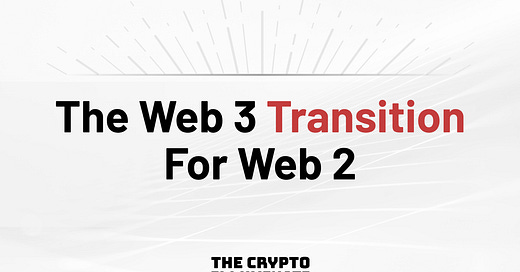The Web 3 Transition For Web 2🥂
Today we look at the different ways we can expect to see Web 3 adapt to the increase in Web 2 enterprise investment and interest in blockchain.
It’s been some time since I have done a sit-down deep dive piece that assesses the entire space. Still, the great part about putting together all the products like “Raises With Russian” and all of the series we have is that I tend to notice reoccurring trends that are often data-related or have some evidence.
This makes life easier when finding talking points that we can cover and give some real insight into our industry.
That was the much-needed catch-up, but I am eager to start getting into the content, so BRB…
Introduction🔬
Crypto has this cultural element where it feels like some exclusive club where you need a golden ticket on entry. Still, if we want to adopt a DEEP user base, the reality is we have to analyze the strategy of Web 2 entry into the market.
What Spiked This Research Piece:
The number of users that Web 3 products are aiming to scale towards is identical to the current Web 2 user base. I wanted to research this because there is a lot of talk about making products user-friendly to appease Web 2 users; however, how will that transition look for people like me and you who spend hours studying the complexity of established crypto infrastructure like DeFi?
Will Protocols Be Built To Be More Suited For Web 2🔩
So I mentioned that I have noticed a lot more protocols look to scale to reach a more significant number of users and the best example we can use is Ethereum, which moved from PoW to PoS.
While the initial motive of Ethereum’s move may lie deep within the obsession for scalability by founder Vitalik, it has the potential to become a much more friendly asset since it reduced its emissions by 99.99%.
Source: Ethereum Blog
This means we can almost expect that all the infrastructure we are familiar with, like NFTs, DeFi, exchanges, and wallets, will offer solutions for users looking for a more simplistic user experience.
An example is Binance launching Binance Lite, an extension of their custodial wallet that offers a minimized version of Binance for users who are less comfortable with their original interface.
This would be an ideal scenario where we wouldn’t see the majority of the current user experience of crypto change. Instead, we would see extensions that aid adoption. In an ideal world, we would have a “Binance Lite” version of every product, but the reality is not every team has the team and deep pockets of Binance and CZ, which is where we could start seeing shifts in experience to cater to users.
That’s when we could start seeing an influx of reports like this, causing teams to change their strategies to cater.
Web 2 Enterprise Investment💰
Looking at data from Raises With Russian, we can see that there has been a large influx of Web 2 enterprise investment coming into the space.
Web 2 enterprises are beginning to build deep portfolios around Web 3, which is evidence of large companies like Samsung, BlackRock, PayPal, and many more taking crypto much more seriously. Investing in products is evidence of confidence, so this aligns with the most active investors in blockchain companies being top 100 public companies, as you can see below!
Crypto has an element of going against the systematic methods of finance which throughout blockchain’s lifetime has caused a blurred relationship between Web 2 and Web 3. However, by analyzing investor trends, we can look for correlations between what products are being picked up by Web 3 venture firms and what investments are being made by Web 2 companies.
Does Simplifying Crypto Have Any Benefit? ⛑
That being said, the question is: would all parties be aligned in working together, or will there be some sort of breakdown that reflects the level of greed we saw months ago with 3AC, Terra, Celsius, and others that everyone is gradually forgetting?
Instead, if they worked together and created a new user experience, a major talking point would be if that would eliminate the complexity of a platform like Curve, for example.
In my opinion, there is not a single answer. You could say that complexity does act as a deterrent and that “complex” nature attaches to the negative sentiment of hacks, thoughts about scams, money laundering, and more.
If we analyze the negative sentiment for Web 3, it puts that argument into perspective.
Final Thoughts🧠
One thing that needs to be considered when analyzing the negative sentiment around Web 2 enterprises entering the space is that the capital Web 2 can bring is incomparable to what we already have in the space (which is already on the up!).
Sometimes we can be too one-dimensional when analyzing the markets and don’t consider frameworks like the creation of jobs and extension of utility despite their importance.
Web 2 underwent all of these phases, and now getting a job that doesn’t revolve around the internet is practically impossible, and that’s a part of how our tech should aim to disrupt.
Subscribe to receive our weekly newsletter and in-house research content!
Please Share, Leave Feedback, and Follow Us on Twitter, Telegram, and LinkedIn to stay connected with us.













